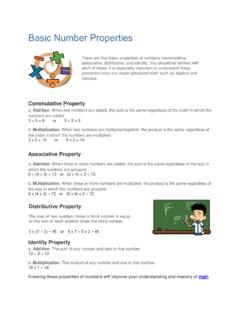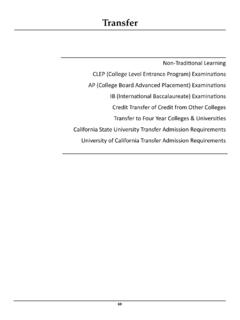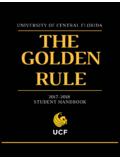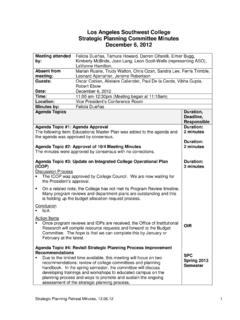Transcription of Michael Wyly, David Williams, Jim DeKloe, & Lisa Abbott 1
1 Michael wyly , David Williams, Jim dekloe , & Lisa Abbott1 UNDERSTANDING OF SENATE AUTHORITY PER CA ED CODE AND TITLE 5, INCLUDING THE 10+1(WHERE/WHY/WHEN TO INSIST ON PROCESS)2ED. CODE & ACADEMIC SENATE PURVIEW Title 3, Division 7: California Community Colleges 70900 General Provisions 70902 Academic Senate has primary responsibility for recommendations regarding curriculum 72000 Districts and Governing Boards 76200 Student Records, including privacy 84000 Finance and Budget 84750 Apportionment and FundingINCLUDES ITS DESIGNEES/SUBCOMMITEES, Curriculum and Basic Skills/LCs3 IMPORTANT SECTIONS OF TITLE 5 Title 5 and the Academic Senate: Section 53200 (b) Defines and empowers academic senates Section 53200 (c) Lists the 10+1 Section 53200 (d) Defines consult collegially, primarily rely, and mutually agree 4 THE "TEN PLUS ONE ACADEMIC SENATEC ommonly known as the "Ten Plus One " (as articulated inTitle 5 of the Administrative Code of California, Sections 53200) the following define "Academic and professional matters.
2 "1. Curriculum including establishing prerequisites and places courses within disciplines2. Degree and certificate requirements3. Grading policies4. Educational program development5. Standards or policies regarding student preparation and success6. District and college governance structures, as related to faculty roles7. Faculty roles and involvement in accreditation processes, including self-study and annual reports8. Policies for faculty professional development activities9. Processes for program review10. Processes for institutional planning and budget development11. Other academic and professional matters as mutually agreed upon between the governing board and the academic senate5 THE SENATE & CURRICULUM COMMITTEE, INCL. SCC LOCAL CULTURE Senate builds the highway Subcommittees direct and control the traffic6 CURRICULUM STREAMLINING AND LOCAL CURRICULUM APPROVAL PROCESS:UNDERSTANDING THE IMPLICATIONS FOR THE ACADEMIC SENATE & CURRICULUM COMMITTEE7 Changes in Process and Authority, CCs, CCCCO, BoG8 FIRST ACTIONS: CREDIT COURSE CERTIFICATIONA nnual Credit Courses document was due December 16, 2016 112 of 113 colleges have now signed the certification and Curriculum Chair signature be due annually on 1 October beginning in CEO and Senate President signatureThis certification applies to the following.
3 Course proposals to existing approved credit programs to existing approved credit change proposals for credit proposals change proposalsfor credit courses 9 CERTIFICATION TIMELINE Credit Course Certification New proposals to new programs New proposals to existing approved credit programs Substantial change proposals Stand-alone proposals Non-substantial change proposals Credit Program Certification Timeline? Non-substantial change proposals Non Credit Courses and Programs Timeline?10 CREDIT COURSES NEED TO DEMONSTRATE THAT THE DOCUMENTS BELOW WERE USED11 LOCAL CERTIFICATION REQUIREMENTSWhen the Curriculum Chair and the Chief Instructional Officer of a college certify these four curriculum items, they are ensuring the following: the college/ district has followed the Program and Course Approval Handbook processes and course and program information is accurate the college / district has followed the CCCCO Course Calculation guidelines and course hours and units are correct the college s / district s governing board has approved the course outline of record and/or program the college / district has provided training regarding curriculum rules and regulations to ensure compliance the college / district has developed local policy, regulations or procedures specifying the accepted relationship between contact hours, outside-of-class hours.
4 And credit for calculating credit hours to ensure consistency in awarding units of creditThese items of assurance are primarily technical pieces; therefore, it is imperative that the Vice President of Academic Affairs partner with the Curriculum Chair and the tech review committee in the technical review process to ensure accuracy in all areas. Once these items are reviewed in the tech review committee and approved by the Curriculum Chair and the VPAA, the curriculum piece will be ready to move forward to the curriculum committee for further discussion on non-technical aspects such as topics, scope and student learning Closing Our Mutual Commitment OF BROWN ACT, INCLUDING LEGAL REQUIREMENTS OF THE ACADEMIC SENATE & ITS SUBCOMMITTEES14 BROWN ACT WE ARE OPEN & PUBLIC The people, in delegating authority, do not give their public servants the right to decide what is good for the people to know and what is not good for them to know.
5 California Government Code 54950 Ralph M. Brown 1959 Photo courtesy The Modesto Bee 15 BROWN ACT: TO WHOM DOES IT APPLY?Applies to meetings of all locallegislative bodies (GC 54952). For any community college, local legislative bodies include: The Board of Trustees; Any subcommittee or task force created by the Board with a majority of Board members serving on the group; Any subcommittee or task force created by the Board which has a definite ongoing charge (either decision-making or advisory) ORhas a regularly-scheduled meeting set by the Board, regardlessof Board BROWN ACT APPLY TO LOCAL ACADEMIC SENATES(& SUBCOMMITTEES)? of Senate (as Subcommittee of the BoT) of the Board of committees, all subcommittees, including the Curriculum Committee17 THEN, WHAT IS A MEETING?
6 A meeting of a local legislative body (GC ) occurs whenever a majority of members gather to discuss business within their charge. A majority can meet for the following items provided they do notdiscuss any business within their charge among themselves: Attendance at a conference; An open meeting of some other group to address local issues (even a Board-recognized group under the definition of legislative bodies ); Social MEETINGS ARE EXPLICITLY NOT ALLOWEDS erial meetings occur when a majority of the members have communicated about an issue and have developed a collective concurrence. A collective concurrence is developed when Members have either directly or indirectly heard each other s opinion on a topic enough to collectively develop or begin to develop an agreement on an issue.
7 19 IMPLICATIONS OF BROWN: include meeting time and location, including address; agenda in a 24/7 publicly accessible area 72 hours before meeting (physically and virtually); meetings require 24 hours notice and are limited to agenda items; do notcall emergency meetings (which do not require 24 hour notice) as public safety is notunder senate jurisdiction; for public comments before or during discussion of agenda items; all action items on the agenda, with a brief description; change order of agenda20 ACTION IS LIMITED TO ITEMS ON THE AGENDA, EXCEPT the need for immediate action was discovered after the agenda was posted, approved by the body with a vote of 2/3 of members present if more than 2/3 of the total membership are present, or a unanimous vote if less than 2/3 of the total members are AND VOTES ARE must be held within your senate s sessions are for litigation (for instance, the senate is or will be sued) personnel matters (such as, the senate has responsibility for evaluating a senate employee) negotiating with a bargaining agent (which the senate does not do).
8 Votes are open! No secret for elections (if they are conducted during senate meetings). It is required that all ayes, nays and abstentions on motions be attributed to member casting a vote! may respond to public comments but not take items distributed by the Senate before or during meetings must be available to the public at the meeting (reasonable fees may be charged for duplication).22 YOU ARE A CURRICULUM REPRESENTATIVESo, now what?23 YOU ARE A CURRICULUM REPRESENTATIVE Becoming familiar with the course standards is probably the first task a new member should undertake. An extremely important role for the Committee member is serving as the communication linkbetween the Curriculum Committee and his/her constituent group Academic Deans, students, and and instructional issues discussed at the Committee meetings need to be taken back to the member s constituent groups, and issues and concerns brought up by constituent groups need to be communicated back to the Curriculum Committee member is responsible for making this two-way communication happen.
9 A primary role of the Committee representative is to know and understand this process and, along with the Dean, to work with the faculty to move through Curriculum Committee representative s signature indicates that the curriculum meets the Curriculum Committee s curriculum is possible that the representative does NOT support the proposal but does feel that the proposal meets the curriculum ROLE/RESPONSIBILITIES OF THE CURRICULUM REP:Duties of the Members Become informed about Curriculum Committee policies and procedures. Attend all scheduled meetings,having read the agenda, minutes, and agenda items beforehand. Study all items listed on the agenda and be prepared for discussion and making recommendations at meetings, per the Course Outline of Record Checklist located in the Curriculum Handbook.
10 Determine the merits of proposals based on an objective analysis of the information presented including the effects upon the college-wide curriculum. Vote to approve or disapprove curriculum proposals and any other appropriate items brought to the Committee for a vote. Make recommendations concerning instructional goals and policies of the College, at the request of the Academic Senate. Serve as liaison from the Curriculum Committee to schools for information regarding curricular issues. Examples: course proposals, calendars, articulation, etc. Inform those making proposals of the date on which the proposals will be considered and the disposition of their proposals by the Committee. And, BE SURE THEY SHOW UP. If a proposal is rejected, make certain proposer is informed of the reason(s) for the rejection.














